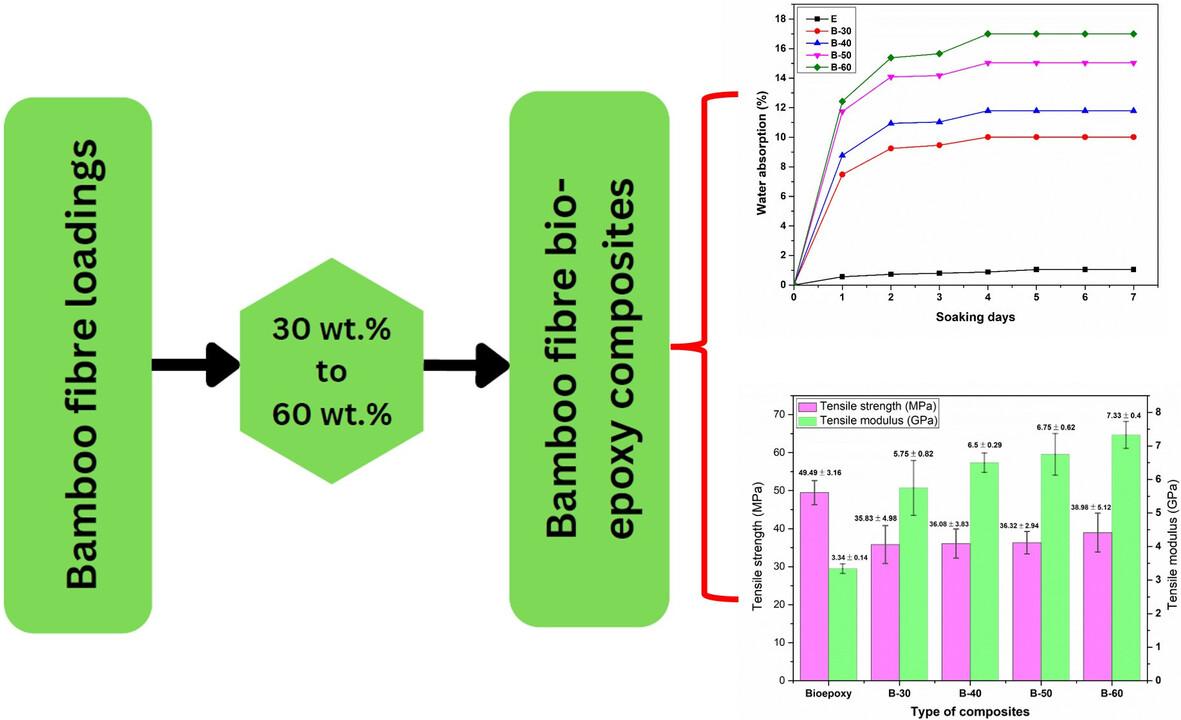M. Chandrasekar, K. Senthilkumar, Hassan Fouad, Mohammad Jawaid, Mohamed Hashem, Ahmad Safwan Ismail, Naheed Saba, Ramzi Khiari
求助PDF
{"title":"Influence of fibre loading on the density, voids, dimensional resilience, tensile characteristics and thermomechanical behaviour of bamboo fibre and bio-epoxy composites","authors":"M. Chandrasekar, K. Senthilkumar, Hassan Fouad, Mohammad Jawaid, Mohamed Hashem, Ahmad Safwan Ismail, Naheed Saba, Ramzi Khiari","doi":"10.1002/pi.6608","DOIUrl":null,"url":null,"abstract":"<p>This paper investigates the influence of bamboo fibre loadings (30, 40, 50 and 60 wt%) on the physical, tensile and dimensional behaviour of short-bamboo-fibre-reinforced bio-epoxy matrix composites. Water absorption, thickness swelling, density, void content, tensile and thermomechanical analysis were determined. The findings indicated that higher fibre loading led to elevated water absorption and increased thickness swelling in bamboo fibre composites. The order of thickness swelling and water absorption behaviour was bio-epoxy < B-30 < B-40 < B-50 < B-60. Similarly, the measured density of composites increased with respect to fibre loading. However, the void content decreased when the fibre loading was >40 wt%. Concerning tensile characteristics, it was observed that all composite materials displayed lower tensile strength compared to the bio-epoxy matrix. However, there was a notable enhancement in the elasticity of the composites. As an example, B-60 exhibited the highest Young's modulus at 7.33 GPa. The analysis of the fracture behaviour of tension-tested samples was conducted using images obtained from SEM. The coefficient of thermal expansion was increased drastically as fibre loading increased. This indicated that the dimensional change was higher. Thus, it is desirable to have lower fibre loading to obtain better dimensional stability under the influence of temperature. © 2023 Society of Industrial Chemistry.</p>","PeriodicalId":20404,"journal":{"name":"Polymer International","volume":"73 5","pages":"378-384"},"PeriodicalIF":2.9000,"publicationDate":"2023-12-22","publicationTypes":"Journal Article","fieldsOfStudy":null,"isOpenAccess":false,"openAccessPdf":"","citationCount":"0","resultStr":null,"platform":"Semanticscholar","paperid":null,"PeriodicalName":"Polymer International","FirstCategoryId":"92","ListUrlMain":"https://onlinelibrary.wiley.com/doi/10.1002/pi.6608","RegionNum":4,"RegionCategory":"化学","ArticlePicture":[],"TitleCN":null,"AbstractTextCN":null,"PMCID":null,"EPubDate":"","PubModel":"","JCR":"Q2","JCRName":"POLYMER SCIENCE","Score":null,"Total":0}
引用次数: 0
引用
批量引用
Abstract
This paper investigates the influence of bamboo fibre loadings (30, 40, 50 and 60 wt%) on the physical, tensile and dimensional behaviour of short-bamboo-fibre-reinforced bio-epoxy matrix composites. Water absorption, thickness swelling, density, void content, tensile and thermomechanical analysis were determined. The findings indicated that higher fibre loading led to elevated water absorption and increased thickness swelling in bamboo fibre composites. The order of thickness swelling and water absorption behaviour was bio-epoxy < B-30 < B-40 < B-50 < B-60. Similarly, the measured density of composites increased with respect to fibre loading. However, the void content decreased when the fibre loading was >40 wt%. Concerning tensile characteristics, it was observed that all composite materials displayed lower tensile strength compared to the bio-epoxy matrix. However, there was a notable enhancement in the elasticity of the composites. As an example, B-60 exhibited the highest Young's modulus at 7.33 GPa. The analysis of the fracture behaviour of tension-tested samples was conducted using images obtained from SEM. The coefficient of thermal expansion was increased drastically as fibre loading increased. This indicated that the dimensional change was higher. Thus, it is desirable to have lower fibre loading to obtain better dimensional stability under the influence of temperature. © 2023 Society of Industrial Chemistry.
纤维负载对竹纤维和生物环氧复合材料的密度、空隙、尺寸回弹性、拉伸特性和热机械行为的影响
本文研究了竹纤维负载量(30wt.%、40wt.%、50wt.% 和 60wt.%)对短竹纤维增强生物环氧基复合材料的物理、拉伸和尺寸行为的影响。对吸水率、厚度膨胀、密度、空隙含量、拉伸和热力学分析进行了测定。研究结果表明,竹纤维复合材料的纤维负载越高,吸水率越高,厚度膨胀越大。厚度膨胀和吸水行为的顺序为 Bioepoxy< B-30< B-40< B-50< B-60。同样,复合材料的测量密度也随着纤维负载量的增加而增加。然而,当纤维含量大于 40wt.% 时,空隙率降低。在拉伸特性方面,与生物环氧基体相比,所有复合材料的拉伸强度都较低。不过,复合材料的弹性明显增强。例如,B-60 的杨氏模量最高,为 7.33 GPa。利用扫描电子显微镜(SEM)获得的图像对拉伸测试样品的断裂行为进行了分析。随着纤维负载的增加,热膨胀系数急剧上升。这表明尺寸变化较大。因此,在温度影响下,最好降低纤维负载,以获得更好的尺寸稳定性。本文受版权保护。
本文章由计算机程序翻译,如有差异,请以英文原文为准。


 求助内容:
求助内容: 应助结果提醒方式:
应助结果提醒方式:


